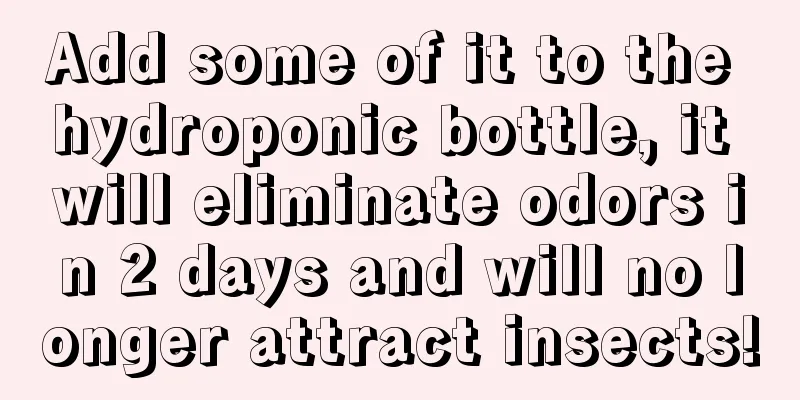Add some of it to the hydroponic bottle, it will eliminate odors in 2 days and will no longer attract insects!

How to determine if the roots are rotten?Look at the rootsObserve the roots of the plant. If they turn yellow, black, and soft, and the epidermis easily falls off, leaving only the lignified part, it means that the roots have rotted. SmellIf you smell a rotten odor from the roots or the water smells bad, it means the roots are rotten. What should I do if the roots are rotten?1. Take the plant out of the hydroponic bottle, rinse it with clean water, and then cut off the rotten roots and tubers; 2. Soak the pruned plant roots in 0.5% potassium permanganate solution or 0.1% carbendazim solution for 20 to 30 minutes; 3. Add a few drops of potassium permanganate solution to the hydroponic bottle for disinfection, wash it and change the water, then put the treated plants in for maintenance. How to prevent root rot?To prevent the plant's roots from rotting, you can add some bactericidal or disinfecting agents or items to the hydroponic bottle every time you change the water. This is not only beneficial to growth, but also saves you time and effort. Ferrous SulfateAdding ferrous sulfate solution to water can supplement iron for plants, and at the same time regulate the acid-base balance of water, thereby preventing yellow leaves and root rot. Dosage and Administration: Dilute ferrous sulfate powder 1000 times with water, and then add 5 to 8 drops to the hydroponic bottle every half a month or so. MetronidazoleMetronidazole can effectively kill anaerobic bacteria in water and prevent the water from becoming smelly due to bacterial infection. Dosage and administration: Mix one metronidazole tablet with 1000 ml of water, and drop a few drops into the hydroponic bottle each time you change the water. charcoalCharcoal has good adsorption and antiseptic properties. Putting it in a bottle can effectively purify water and prevent plant roots from rotting. Dosage and Administration: Add 5 to 7 thumb-sized pieces of charcoal into the bottle each time you change the water to prevent corrosion. Rusty nailsPutting rusty iron nails in water has the same working principle as ferrous sulfate solution, which can replenish iron to the leaves and prevent yellowing and rot. The operation is simple but the effect is slow. Usage and Dosage: Throw 2 to 3 rusty nails directly into the water, and take them out and reuse them every time you change the water. CarbendazimCarbendazim can also play a good disinfecting and sterilizing role. Adding it to water can prevent root rot and heal wounds. Dosage and Administration: Dilute the carbendazim solution with water according to the instructions, and add a few drops to the hydroponic bottle every 3 to 5 days. In summer, hydroponic plants are very important for antiseptic Flower lovers, remember to change the water frequently. |
>>: What fertilizer is best for succulents?
Recommend
How to fertilize cornstone
The need for fertilizer Corn stone does not need ...
Can mango trees be planted in the south?
Can mango trees be grown in the south? Mangoes ca...
When is the right time to prune the keel?
Keel pruning effect When the dragon bone flower g...
How often should I water the Jasper?
How often should I water Jasper? Jadeite does not...
Three common misunderstandings about flower cultivation
Misconception 1: Water more. Giving flowers more ...
How to grow the Alocasia odora until it fills the pot?
The appearance of the Avalokitesvara yin lotus is...
Cultivation methods and precautions of alpine banyan
1. Soil The mountain banyan has very low soil req...
Cultivation and precautions of zapota
1. Lighting The lily of the valley is a plant tha...
Diseases and Pests of Silk Flower and Their Control
Diseases of Silk Flower and Their Prevention and ...
Can the fruit of the fortune tree be eaten? Why are the leaves turning white?
1. Can I eat it? The fruit of the money tree can ...
Can peonies be planted in pots?
Can peony be planted in a flowerpot? Peonies can ...
Are there so many benefits to hydroponic plants?
Purify the air and benefit your health Scientific...
How to grow nasturtium until it overflows the pot
1. Suitable soil To grow nasturtium, you need to ...
How to reproduce the dew lily
1. Propagation by seeding Generally speaking, dew...
How to take care of clams?
Flower clams, also known as flower clams, are a v...









